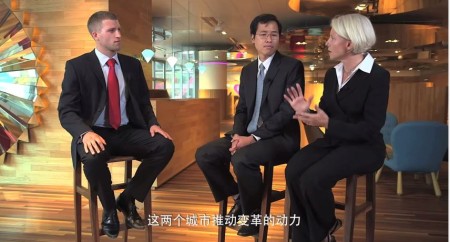By Chelsea Eakin
Beijing’s skies are getting bluer, and China recently announced its climate action plan, submitting its commitments to the UN ahead of Paris climate talks in December. At the same time, everyone is talking about China’s “new normal” – a more sustainable growth rate and a rebalancing of the economy, involving massive structural changes that shift emphasis from investment to consumption.
What does all this news have in common? Elle Carberry, a managing director in the Paulson Institute’s Beijing office, recently sat down with China Carbon Forum to connect the dots between the economic and environmental side of what’s happening on the ground in China. Here are three highlights from the interview:

On the question of whether China needs to sacrifice GDP growth to ensure blue skies:
Our response is that economic and environmental prosperity go hand in hand. The good news now is that many years after environmental laws were implemented in other nations and enforced, we can see the 30, 40 years of experience from places like LA and Pittsburg, where they were quite strong on enforcing the law, rebalancing their industrial mix, and now these cities are growth engines across a diversified set of industries – many are cleaner, greener, manufacturing services and other kinds of industries. So those are wonderful proof points that you can achieve both and frankly, in both of those cities, their impetus to change was caused because of environmental problems and pollution, and from some of the same industries that are causing the pollution here in China.
On what’s happening in the Jing-Jin-Ji region (Beijing, Tianjin and Hebei):
Jingjinji is a heavy industry area but also has plenty of emerging examples of new industries that are being created, be it renewable, be it green building, be it the services industries that accompany those. We are trying to bring more awareness to these new industries that are growing up as well as thinking about how do you help control the emission from the heavy industries. We are very supportive of the government and also the overall reform agenda, which is trying to focus on domestic demand and reduce this investment-led culture, which led to overcapacity in many heavy industries. So that range of environmental and economic policies is the place where we are working closely. It’s the mix of those things working together. That’s also why we also believe that those two things can occur together – economic and environmental prosperity. There are proof points that show that that is a path forward and we are trying to help make that possible now in China.
On how to best strengthen the US-China relationship:
We focus on the US-China bilateral relationship from the belief that the two largest economies and two largest emitters in the world need to lead from the front. We are trying to enable that, in particular by looking at how does one invest in the environment as a common agenda between the nations and then through that create sustainable economic growth for both nations. We think of investment in the environment as the common agenda and the way to grow.
Watch the full video interview here:


